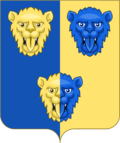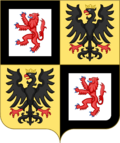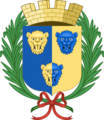Coat of arms of Durland: Difference between revisions
| Line 119: | Line 119: | ||
|align="center"|[[File:Coat of arms of Johamara, Princess Eirmar of Mardan.png|90px]] | |align="center"|[[File:Coat of arms of Johamara, Princess Eirmar of Mardan.png|90px]] | ||
|align="center"|Johamara, Princess Eirmar<br><small>Granddaughter-in-law; wife of Prince Eirmar</small> | |align="center"|Johamara, Princess Eirmar<br><small>Granddaughter-in-law; wife of Prince Eirmar</small> | ||
|The arms of Prince Eirmar impaled with those of her father, Freedal Kelhite. The crown is that of a Prince of Leps. | |The arms of Prince Eirmar impaled with those of her father, Freedal Kelhite. The crown is that of a Prince of Leps. The arms of Freedal Kelhite is a reference to the family's origins in Bamerin County, the traditional colours of which are red and white, and in Letdi, which traditionally uses five hearts. | ||
|- | |- | ||
|align="center"|[[File:Coat of arms of a member of the Princely House of Leps.png|90px]] | |align="center"|[[File:Coat of arms of a member of the Princely House of Leps.png|90px]] | ||
Revision as of 10:15, 17 February 2024
| Coat of arms of Durland | |
|---|---|
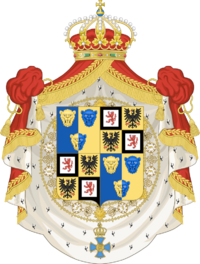 Greater (royal) version | |
| Versions | |
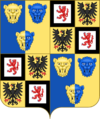 Middle version | |
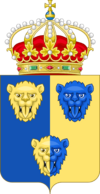 Lesser (state) version | |
| Armiger | Carilla, Princess of Durland |
| Adopted | Initially adopted on 14 August 1876. Modified 1877. Readopted 9 April 1928. |
| Torse | tasseled strings Or |
| Blazon | Quarterly, I and IV Per pale Azure and Or btween three leopard heads caboshed all countercharged. II and III Argent a lion rampant Gules within a bordure Sable impaling Or, an eagle displayed sable beaked and membered Gules and Crowned Or. |
| Orders | Order of Prince Jora |
| Other elements | The monarch places this coat of arms on a mantle gules lined with Ermine. Above the mantle is a pavilion gules again topped with the royal crown. |
The coat of arms of Durland is the arms of dominion of Princess Carilla of Durland, and is used to represent both the monarch and the state. The shield quarters the attributed arms of Prince Jora and the House of Leps, representing the state and the ruling house respectively.
The coat of arms is used to represent the authority of the state; the monarch, government, and Supreme Court all use versions of the arms to assert their legitimate authority. The government uses a variation of the arms without mantle or order, which is known as the state arms. Members of the Princely Family maintain their own arms for use in a private capacity.
History
Prior to Garindinian colonisation, Durland was a collection of petty principalities united under the common rule of a Grand Prince. There were various armorials used by and attributed to these rulers. Prince Jora, who reigned as Grand Prince between 1527 and 1574, adopted a vertically-divided shield of blue and gold countercharged with three leopards heads. Jora's successors (including both legitimate descendants and unrelated rulers) continued to use these arms until Durland's eventual colonisation.
On Durland's independence, the government resurrected the arms of Prince Jora, claiming direct continuity with the pre-colonial Durlish principalities. With the election of Farnar II as prince, these arms were quartered with those of the House of Leps, the new ruling dynasty. The eventual design, including crown and mantle, were designed by Farnar himself; an amateur herald and artist, he reportedly designed the arms on the back of an envelope whilst en route to Herran. Although in use from 1875, the arms were not officially registered until 1876. On the creation of the Order of Prince Jura the following year, the arms were amended to include the order as a circlet around the escutcheon.
| The Arms of Prince Jora. | The Arms of the House of Leps. |
In 1922, following the abolition of the monarchy and the establishment of the Second Durlish Republic, the coat of arms was redesigned to remove all references to the monarchy. The armorial of the House of Leps was removed, as was the crown and order. The mantle was replaced with a wreath, with the princely crown replaced by a mural one. Proposals for a wholly new emblem severing all connection with the previous regime were initially made, but never carried through.
On the restoration of the monarchy in 1928, the princely arms readopted. In 1967, new regulations established a new state coat of arms consisting solely of the arms of Prince Jora, redesignating the quartered arms as the arms of the princely house. Nonetheless, the greater arms continues to be the arms of the state as a symbol of the Crown's role as embodiment of the state.
Description
The current coat of arms was adopted in 1928 following the re-establishment of the monarchy. It is closely modelled on the coat of arms previously used from 1878 until 1922. As per the registration with the Court of Arms, the escutcheon is blazoned: Quarterly, I and IV Per pale Azure and Or btween three leopard heads caboshed all countercharged. II and III Argent a lion rampant Gules within a bordure Sable impaling Or, an eagle displayed sable beaked and membered Gules and Crowned Or. The shield is surrounded by the insignia of the Order of Prince Jura, and all surrounded by mantling Gules doubled ermine, crowned with the royal crown and tied up with tassled strings Or.
The rules outlining the design and use of the coat of arms, including variations and eligibility, continue to be based on those made by Farnar II.
Usage
The proper use of the Durlish coat of arms is regulated by law. The National Sybols Act 2003, which updated and consolidated existing legislation relating to the coat of arms, identifies three types of arms used in Durland: the great coat of arms, the state coat of arms, and the shield of arms (or escutcheon).
- The great coat of arms is the arms of dominion of the Durlish monarch, and subsequently serves as the coat of arms of the Reigning Prince(ss) and also of the state. It is used to represent the Crown and the nation. The quartered shield, when used in a state capacity, represents the Crown as the embodiment of the nation.
- The lesser coat of arms is the crowned arms of Prince Jora, and is used by the government and other state authorities.
- The shield of arms is the general design of the escutcheon, as used in either the great or state coat of arms or as part of the personal arms of individuals.
The distinction between the great coat of arms and the state coat of arms is not clearly made. The great coat of arms generally represents the monarch and non-executive state institutions (e.g., Parliament, the courts, the armed forces etc.), whereas the state coat of arms represents the government and state. The Durlish passport, as government property, uses the state arms.
Variants
Princely family
Members of the Princely Family are granted their own personal arms. The arms of the monarch are those of the state (arms of dominion). Children of the monarch are able to bear their own arms, which are usually granted on their twenty first birthday unless eligibility precedes this age, which consist of the monarch's arms differenced with a white label. Other members of the princely family may be granted arms at the direction of the monarch. In accordance with rules established by Farnar II, the arms of the monarch's children are differenced with a three-point label, whilst those of grandchildren are differenced with a five-point label. The labels are always white and include individual marks to form the particular difference.
Princess consorts and the wives of the monarch's sons also have their own personal arms, which consists of the arms of their husbands impaled with either their own or their father's arms. Males who marry into the princely family display their own arms as an inescutcheon.
Currently the following members of the princely family have their own arms based on the royal arms:
